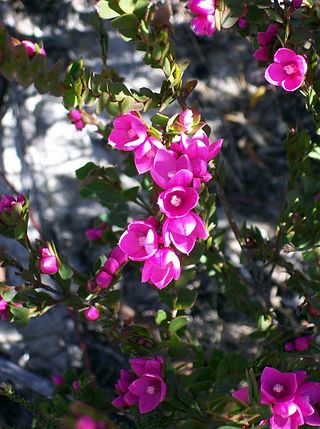
Boronia serrulata, commonly known as native rose or rose boronia, is a species of plant in the citrus family, Rutaceae, and is endemic to New South Wales, mainly in the Sydney basin. It is an erect, woody shrub with glabrous branchlets, simple, egg-shaped leaves with fine teeth on the edges, and bright pink, four-petalled flowers on the ends of the branchlets.

Boronia muelleri, commonly known as the forest boronia or pink boronia, is a flowering plant that occurs in forest, woodland and heath in Victoria and New South Wales in Australia. It is an erect, woody shrub or small tree with pinnate leaves and up to fifteen pink to white four-petalled flowers arranged in leaf axils in spring and summer.

Boronia mollis, commonly known as soft boronia, is a plant in the citrus family and is endemic to New South Wales. It is a shrub with pinnate leaves, and small groups of pink flowers in leaf axils. It grows in coastal areas in forest.

Cyanothamnus anemonifolius, commonly known as narrow-leaved boronia or sticky boronia, is a flowering plant that is endemic to south-eastern Australia. It is a shrub with mostly pinnate leaves, with white to pale pink four-petalled flowers in leaf axils.

Cyanothamnus nanus, commonly known as the dwarf boronia or small boronia is a plant in the citrus family Rutaceae and is endemic to eastern Australia. It is a prostrate or low spreading shrub with simple or three-part leaves and white or pale pink four-petalled flowers.

Boronia decumbens is a plant in the citrus family Rutaceae and is endemic to northern parts of the Northern Territory. It is a low, spreading shrub with pinnate leaves and white to pink flowers with the four sepals larger than the four petals.

Boronia excelsa is a plant in the citrus family Rutaceae and is endemic to a small area in Far North Queensland. It is an erect shrub with woolly-hairy branches, simple, stalkless, more or less hairless leaves, and pink to white, four-petalled flowers.

Boronia galbraithiae, commonly known as the aniseed boronia or Galbraith's boronia, is a plant in the citrus family Rutaceae and is endemic to a small area in Victoria. It is an erect, woody, fennel-scented, hairless shrub with pinnate leaves and white to deep pink, four-petalled flowers arranged in groups in the leaf axils.
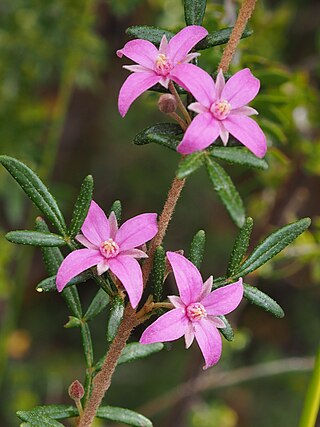
Cyanothamnus inflexus is a plant in the citrus family Rutaceae and is endemic to tablelands near the New South Wales - Queensland border in Australia. It is an erect, woody shrub with pinnate leaves and up to seven white to pink four-petalled flowers in the leaf axils. Boronia bipinnata is similar but has larger, bipinnate or tripinnate leaves and smaller sepals and petals.
Cyanothamnus montimulliganensis is a plant in the citrus family Rutaceae and is endemic to a single mountain in Queensland. It is an erect, woody shrub with pinnate or bipinnate leaves and white, four-petalled flowers usually arranged singly in leaf axils.
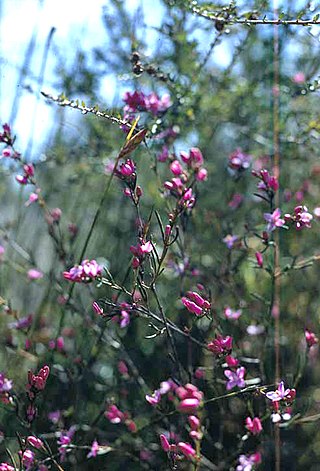
Boronia nematophylla is a plant in the citrus family Rutaceae and is endemic to the south-west of Western Australia. It is a shrub with thin, simple leaves and pale red to purple, four-petalled flowers arranged singly or in small groups in leaf axils.
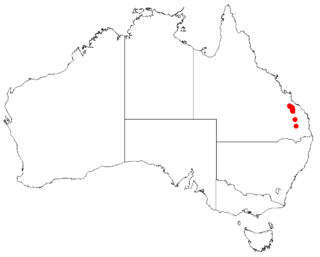
Boronia palasepala is a plant in the citrus family Rutaceae and is endemic to a small part of Queensland, Australia. It is an erect, rounded shrub with many branches, simple leaves and pink to white, four-petalled flowers.

Boronia parviflora, commonly known as the swamp boronia, small boronia, tiny boronia, or small-flowered boronia, is a plant in the citrus family Rutaceae and is endemic south-eastern Australia. It is a weak, low shrub with elliptic to egg-shaped leaves with finely toothed edges and up to three pink, white or green four-petalled flowers arranged at or near the ends of the stems.

Cyanothamnus polygalifolius, commonly known as dwarf boronia, milkwort-leaved boronia or milkwort boronia, is a plant in the citrus family Rutaceae and is endemic to eastern Australia. It is a low-lying shrub with simple leaves and white or pink flowers arranged singly or in groups of up to three in leaf axils.

Boronia prolixa is a species of plant in the citrus family Rutaceae and is endemic to a small area in the Northern Territory, Australia. It is a low-lying shrub with hairy branches, leaves and flower parts, simple leaves and white to pink flowers with the sepals longer and wider than the petals.
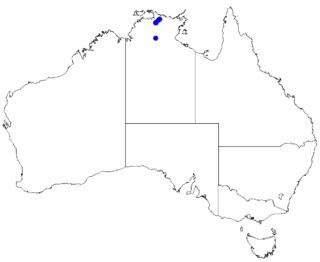
Boronia rupicola is a species of plant in the citrus family Rutaceae and is endemic to a small area in the Northern Territory, Australia. It is a small shrub with weeping branches, simple or pinnate leaves and small, green, inconspicuous flowers.

Boronia squamipetala is a species of plant in the citrus family, Rutaceae, and is endemic to Queensland, Australia. It is an erect shrub with pinnate leaves with between five and thirteen elliptic leaflets, and green to white, four-petalled flowers with hairy backs.

Boronia tolerans is a plant in the citrus family, Rutaceae and is endemic to a small area in the Northern Territory in Australia. It is an erect shrub with many branches, pinnate leaves and white, four-petalled flowers. It is only known from Nitmiluk National Park.
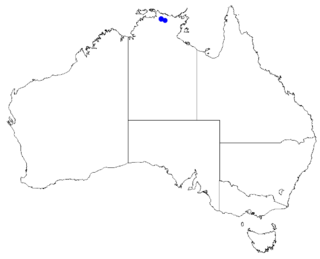
Boronia viridiflora is a species of shrub that is endemic to a small area in the Northern Territory and grows horizontally from vertical rock faces. The flowers are borne singly or in groups of up to three in leaf axils and are green with a burgundy tinge.
Boronia zeteticorum is a species of small, semi-prostrate shrub that is endemic to a restricted part of the Northern Territory. It has hairy branches, leaves and flower parts, simple leaves and white flowers with the sepals longer and wider than the petals.


















